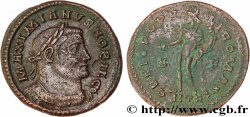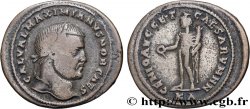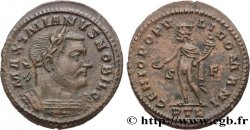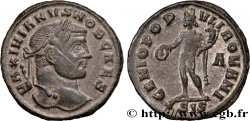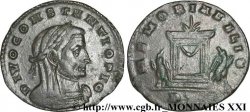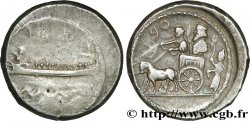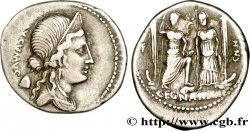v41_1126 - GALERIO Aurelianus
MONNAIES 41 (2009)
Prezzo di inizio : 350.00 €
Valutazione : 700.00 €
lotto invenduto
Prezzo di inizio : 350.00 €
Valutazione : 700.00 €
lotto invenduto
Tipo : Aurelianus
Data: 294
Nome della officina / città: Gaule, Lyon
Metallo : billone
Titolo in millesimi : 50 ‰
Diametro : 23 mm
Asse di coniazione : 6 h.
Peso : 3,86 g.
Grado di rarità : UNIQUE
Officine: 2e
Emission: 12e
Commenti sullo stato di conservazione:
Exemplaire sur un flan très large ovale et bien centré. Très beau portrait. Frappe molle et flan légèrement taché au revers. Patine grise avec des reflets métalliques
N° nelle opere di riferimento :
Diritto
Titolatura diritto : MAXIMIANVS NOB C.
Descrittivo diritto : Buste radié, drapé et cuirassé de Galère César à droite, vu de trois quarts en avant (A).
Traduzione diritto : “Maximianus Nobilissimus Cæsar”, (Maximien très noble césar).
Rovescio
Titolatura rovescio : ORIE-N-S - AV-GG/ -|-// D.
Descrittivo rovescio : Sol (le Soleil) radié et nu debout à gauche, le manteau flottant sur l'épaule, levant la main droite et tenant un fouet de la gauche.
Traduzione rovescio : “Oriens Augustorum”, (L’Orient des augustes).
Commento
Avec l’intégralité de son argenture superficielle. Rubans de type 3 aux extrémités bouletées. Ptéryges invisibles sous le paludamentum. Sur cet exemplaire, nous semblons voir un D à l’exergue pour la quatrième officine. Mais Lyon ne fonctionne alors qu’avec trois officines. Se pourrait-il qu’une quatrième officine ait fonctionné ? C’est possible, mais peu probable. Notre D ressemble un peu à celui de l’exemplaire du Staatliche Museen de Berlin, Bastien n° 642b, pl. XLV. Mais si ce n’est pas le cas, il faudra pouvoir expliquer ce D à l’exergue de ce revers : ouverture d’une quatrième officine ou méprise d’un scalptor distrait ?.
With all of its surface silvering. Type 3 ribbons with rounded ends. Pteryges invisible under the paludamentum. On this example, we seem to see a D in the exergue for the fourth pharmacy. But Lyon then only operated with three pharmacies. Could it be that a fourth pharmacy operated? It's possible, but unlikely. Our D looks a bit like the one in the example from the Staatliche Museen in Berlin, Bastien no. 642b, pl. XLV. But if this is not the case, we will have to be able to explain this D in the exergue of this reverse: opening of a fourth pharmacy or mistake by an absent-minded scalper?
With all of its surface silvering. Type 3 ribbons with rounded ends. Pteryges invisible under the paludamentum. On this example, we seem to see a D in the exergue for the fourth pharmacy. But Lyon then only operated with three pharmacies. Could it be that a fourth pharmacy operated? It's possible, but unlikely. Our D looks a bit like the one in the example from the Staatliche Museen in Berlin, Bastien no. 642b, pl. XLV. But if this is not the case, we will have to be able to explain this D in the exergue of this reverse: opening of a fourth pharmacy or mistake by an absent-minded scalper?








 Segnalare un errore
Segnalare un errore Stampate la pagina
Stampate la pagina Condividi mia selezione
Condividi mia selezione Fai una domanda
Fai una domanda Consegnare / vendere
Consegnare / vendere
 Descrittivo
Descrittivo